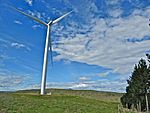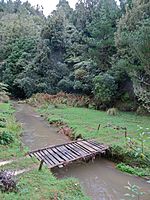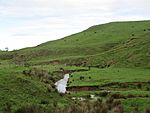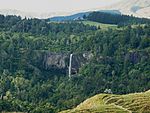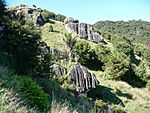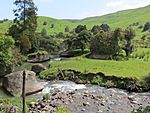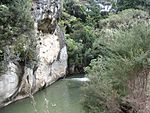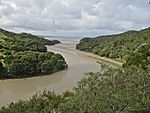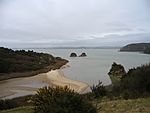Pakoka River facts for kids
Quick facts for kids Pakoka River |
|
|---|---|

The Pakoka River in flood with sediment loading
|
|
| Country | New Zealand |
| Physical characteristics | |
| Main source | Wharauroa Plateau 490 m (1,610 ft) |
| River mouth | Aotea Harbour 0 m (0 ft) |
| Length | 21 km (13 mi) |
| Basin features | |
| Basin size | 3,227 ha (7,970 acres) |
The Pakoka River is a cool river located in the Waikato Region of New Zealand's North Island. It starts flowing from a high area called the Wharauroa Plateau and makes its way southwest. Finally, it reaches the top end of the Aotea Harbour. The river and all its smaller streams cover a total area of over 86 kilometers (about 53 miles).
Contents
How the Pakoka River Valley Was Formed
Ancient Rocks and Volcanoes
The most interesting features of the Pakoka valley were shaped by ancient volcanoes about 2 million years ago. These volcanoes created rocks called the Okete Volcanics. These rocks form the top of the Wharauroa Plateau, which is where the Pakoka River begins.
Volcanic lava also flowed from a spot near Bridal Veil Falls. This lava blocked the valley, helping to create the beautiful falls we see today.
The River's Journey Through Time
From its start, the river quickly drops about 200 meters (656 feet). As it flows, it cuts into a type of rock called Coleman Conglomerate. This rock formed about 150 million years ago and is a mix of sandstone, siltstone, and small volcanic pebbles.
You can also see a cool rock arch and several tall cliffs along the river. These are made of Ahirau Sandstone, which formed about 28 million years ago. Even though it's called sandstone, it looks a lot like limestone. It has a lot of calcium carbonate, which is the same stuff that makes up seashells. This gives it unique features, like grooves and holes, similar to those found in karst landscapes.
Another main type of rock in the valley is Hauturu Sandstone, which is about 30 million years old. This rock often has bumpy parts because it's a mix of hard, limy sandstone and softer, sandy areas.
Plants and Animals of the Pakoka River
Life Around the River
About two-thirds of the land around the Pakoka River is used for farming, mostly for pasture. The rest is covered by trees and bushes. In 2014, less than 10% of the river area was fenced off from farm animals.
You might spot some special birds here, like the New Zealand fernbird and the Spotless crake.
Near where the river meets the harbor, you'll find different kinds of plants. Trees like akeake, kanuka, and kowhai grow along the estuary. You might also see Spartina grass and patches of sea meadow. Further downstream, there are bands of saltmarsh ribbonwood and wetlands with marsh clubrush and raupo. In the mud flats, small patches of seagrass grow. You can even find mangrove trees and saltwater paspalum grass.
Protecting the River
Good news! People are working hard to protect the Pakoka River. Money from the Te Uku Wind Farm and help from local farmers and the Regional Council have made a big difference. A group called Whaingaroa Harbour Care has put up 15 kilometers (about 9 miles) of fences. These fences protect the river and its smaller streams. They have also planted 150,000 trees in the valley above Bridal Veil Falls.
After that, they started a project to control pests like possums and rats. This project is done together with the Department of Conservation.
Tiny Creatures in the Water
Scientists have studied the health of the streams in the Pakoka area. They use a "Stream Health Index" to score how clean the water is. Scores range from 60 (poor) to 170.5 (excellent). In 2006, they found different types of macroinvertebrates (tiny creatures without backbones) that tell us about water quality. The higher the score for a species, the more sensitive it is to pollution.
| MCI score | Species | Prevalence | |||
|---|---|---|---|---|---|
| 9 | caddisfly (Olinga feredayi) | rare | |||
| 9 | spiny-gilled mayfly (Coloburiscus humeralis) | occasional | |||
| 8 | mayfly (Deleatidium) | rare | |||
| 7 | caddisfly (Rhyacophilidae) | occasional | |||
| 7 | dobsonfly (Archichauliodes diversus) | occasional | |||
| 7 | mayfly (Zephlebia) | rare | 6 | riffle beetle (Elmidae) | occasional |
| 5 | stony-cased caddisfly (Pycnocentrodes) | occasional | |||
| 5 | crustacea (Paratya curvirostris) | rare | |||
| 4 | mud snail (Potamopyrgus antipodarum) | abundant | |||
| 3 | sand fly (Austrosimulium) | occasional |
Fish in the Pakoka River
The NIWA Freshwater Fish Database shows that the Pakoka River is home to several types of fish and other water creatures. You can find longfin eels, koura (freshwater crayfish), Cran's Bully (Gobiomorphus basalis), redfin bully, banded kokopu, and smelt.
Gallery


